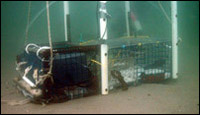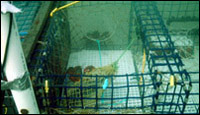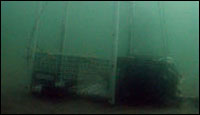 Graduate students launching LTV
|
|
 LTV on bottom with lobster entering
|
|
 LTV with lobster inside
|
|
 LTV on ocean floor
|
Lobster Trap Video (LTV)
What is LTV (lobster trap video)?
LTV consists of a traditional two parlor lobster trap equipped with a time-lapse video recording system. We are able to obtain 24-48 continuous hours of video during each soak, depending on whether we use lights and record at night. We can then take these videos and analyze the movements and interactions of the lobsters around the trap.
LTV was first developed as part of a UNH Ocean Projects course, and then Sea Grant funds were used to improve it. If you would like a short video about this project, send us $5 to cover the cost of copying of the tape and postage. If you would like to read a publication about LTV, coauthored by Steve Jury, go the the Publications section of this site.Click on images to enlarge.
Current Projects
Currently, we are comparing data collected with LTV, traditional traps, and diver surveys to determine why catch in traps does not accurately correlate with the density of lobsters on the ocean floor. We are also using ultrasonic tracking in association with LTV to determine the area fished by a trap.
Our goal is to develop a more accurate way to easily and accurately assess the actual abundance of lobsters on the ocean floor. These studies are being carried out at our Wallis Sands study site, adjacent rocky habitats and waters off of Newcastle Island (see the following sections and the Ultrasonic Tracking Project for details).
